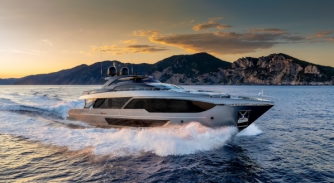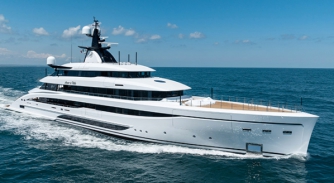Liechtenstein family holdings for superyachts
Governance first, tax re-thought after Germany’s 2025 ruling – how Liechtenstein family holding stands as a yacht vehicle…

Over the years we’ve been asked to design yacht-holding structures by putting foundations on the top. An update of the legal framework is an opportunity to introduce a very interesting example of design structure for HWI-yachting engagement.
What Germany’s Federal Fiscal Court opened up and how EU vs non‑EU principals should now design their structures
The phone call that starts these projects always asks about tax. The conversation that succeeds starts with governance. Liechtenstein’s toolbox – Stiftung (foundation), Anstalt (establishment) and trust under the PGR [Law on Persons and Companies ] – earns its berth because it separates title from day‑to‑day decisions, protects family control and plans succession cleanly. Tax follows the form only when the form is honest. And since spring 2025, the legal current in Europe is running a little clearer.
The decision that changed the tide
On 24 April 2025 Germany’s Federal Fiscal Court (BFH) published its judgement of 3 December 2024 (IX R 32/22). In plain terms: Germany’s escape clause in § 15(6) AStG [Foreign Transaction Tax Act] – long read as a safe harbour only for EU/EEA family foundations – also applies to third‑country foundations and trusts where two conditions are met: (i) effective exchange of information, and (ii) a civil‑law loss of the settlor’s power of disposal (no mere paper exercise). The court grounded this in the free movement of capital and the primacy of EU law. For yacht families this matters beyond Germany: it validates well‑drafted family foundations as legitimate governance vehicles, rather than suspect “boxes”, and it sharpens what evidence you must keep to prove the separation is real.
What Liechtenstein actually brings on board
Liechtenstein is EEA, not EU: it sits inside the single market rule‑set while retaining its own corporate law and tax. Corporate income is taxed at a flat 12.5 per cent, with a minimum tax of CHF1,800. For Private Asset Structures (PAS), the rule is simple but strict: no economic activity – think passive holding and asset management only; the moment you earn charter income, you are out of PAS territory and into ordinary corporate tax. In practice, PAS fits title and family governance; any commercial chartering needs to live with an operator that has people, premises and a VAT position where it trades.
Customs and VAT realities you can’t paper over
For non‑EU yachts cruising the EU, Temporary Admission (TA) is generous but exacting: relief hinges on the yacht being owned/used by persons established outside the EU customs territory, and the relief is time‑limited. TA is not a charter business model and it does not convert EU‑resident family use into a free ride. If an EU‑resident principal wants regular private use, the honest path is import + VAT (or placing the yacht into compliant commercial circulation under an EU operator).
After the BFH: what changes for EU‑resident principals
The BFH ruling removes an unnecessary cliff edge around § 15(6) AStG, but it does not switch off Member‑State Controlled Foreign Company (CFC) rules for operating income or passive cash flows. In 2024/25, those rules tightened and aligned with Pillar Two optics:
• Germany cut its CFC low‑tax trigger to 15 per cent from 2024 and refreshed its AStG guidance. Passive‑heavy structures are exposed unless real people and functions sit with the entity claiming the income. Try to run chartering from Vaduz [the capital of Liechtenstein] without substance and you will be imputed at home.
• Italy re‑tooled Art. 167 TUIR and introduced an optional 15 per cent substitute tax, but the escape is still genuine activity: premises, staff and decision‑making where the CFC lives, not an address.
• France continues to apply Article 209 B CGI to profits of entities under a “privileged” regime unless the EU/EEA safe‑harbour or business‑purpose defence is satisfied. The doctrine is explicit: anti‑abuse first, form follows substance.
• Spain runs international transparency (Article 100 LIS), pulling positive income of low‑taxed, controlled entities into the Spanish base unless there is an adequate organisation of material and human means. A bare title‑holder booking related‑party hire is the classic fail.
What the BFH does give EU residents: permission to use a well‑drafted Liechtenstein family foundation (or trust) for control and succession without tripping family‑foundation CFC solely for being non‑EU – provided the exchange‑of‑information and civil‑law separation are demonstrably real. It does not bless running a charter business from a passive box.
Yes, a Liechtenstein family holding is still a first‑class yacht vehicle in Europe – more so after the BFH 2025 clarification – if you use it for what it does best: governance, separation, succession.
Non‑EU residents: different passports, same physics
If you live outside the EU, Liechtenstein pairs cleanly with TA for private cruising – again, only if both owner and user are non‑EU and only within TA limits. If you are UK‑resident, remember two freestanding risks: the Transfer of Assets Abroad (TOAA) rules (taxing “power to enjoy” offshore income) and benefit‑in‑kind charges when a company yacht is made available to a director or employee for private use. These bite independently of where the title sits.
A 2025 guide that works in practice — one checklist
Title and governance first
Put title and family governance in a Liechtenstein Stiftung or Anstalt drafted to separate ownership from use, with clear rules on eligibility and arm’s‑length pricing for any related‑party use.
Put the sails in the EU
Run commercial charter through an EU operator with real people, premises and risk. That operator – not Vaduz – imports, accounts for VAT and runs the booking engine/crew. The Liechtenstein vehicle remains a title and family governance holder, not a business.
Design for CFC from day one
Align cash flows and contracts so the holding stays holding. Keep board minutes and decision logs where the substance really sits. Remember Germany’s 15 per cent low tax threshold (from 2024) and the AStG guidance on coordinated behaviour and “near passive” income – similar substance tests exist across Italy/France/Spain.
Make cash flows CFC-aware
Time dividends/interest, structure charter payments and intercompany terms to avoid a purely passive profile at the holding level and to respect each jurisdiction’s anti-abuse line.
Customs and VAT honesty
TA is time limited and for non-EU owners/users; it is not a charter model. For EU residents, either the yacht is in commercial circulation under an EU operator or it is imported with VAT paid.
Private availability: say it, price it or block it
EU resident principals should not rely on TA for family use. UK resident principals must hard-block availability or price/tax it transparently to avoid Transfer of Assets Abroad (TOAA) and benefit in kind charges.
Evidence the BFH criteria (2025)
Keep a provable information exchange trail and documents showing the civil law loss of disposal over assets (foundation deed, by laws, protector limitations). This is exactly what the BFH 2025 ruling rewards.
Registers and reporting hygiene
Keep UBO filings in Liechtenstein current; defend treaty positions with genuine mind and management records; and ensure DAC6/MDR and other local disclosure duties are met by EU side intermediaries.
What fails? “All‑in‑Vaduz” conglomerates that invoice charters without crews, bases or booking desks; PAS/PVS entities that try to book charter revenue; or title‑holders that leave a yacht available to a resident shareholder, inviting VGA (hidden distribution in Germany) or benefit‑in‑kind (UK).
The short answer owners may ask for
Yes, a Liechtenstein family holding is still a first‑class yacht vehicle in Europe – more so after the BFH 2025 clarification – if you use it for what it does best: governance, separation, succession. Let the EU operator carry the commercial and VAT weather. Keep the TA story straight and document the separation the way a court would want to see it. Do that, and the structure stops being an argument and starts being an asset.
As an open-source platform we offer an industry-wide invitation to anyone and everyone in our sector to share their knowledge, experience and opinions. So if you have an interesting and valuable contribution to make, and would like to join our growing community of guest columnists, share your ideas with us at newsdesk@thesuperyachtgroup.com
NEW: Sign up for SuperyachtNewsweek!
Get the latest weekly news, in-depth reports, intelligence, and strategic insights, delivered directly from The Superyacht Group's editors and market analysts.
Stay at the forefront of the superyacht industry with SuperyachtNewsweek
Click here to become part of The Superyacht Group community, and join us in our mission to make this industry accessible to all, and prosperous for the long-term. We are offering access to the superyacht industry’s most comprehensive and longstanding archive of business-critical information, as well as a comprehensive, real-time superyacht fleet database, for just £10 per month, because we are One Industry with One Mission. Sign up here.
Related news

Ferretti Group reports strong growth as superyacht share doubles
The Italian builder has 47 vessels over 30 metres currently under construction and six premieres at this year's Monaco Yacht Show
Business

When labour law meets luxury
Professor Dr Christoph Ph. Schließmann outlines the new MLC imperatives for superyacht owners
Owner

Italy’s top builders post steady Q1s as sector shifts
With strong backlogs and increased focus on bigger builds, Sanlorenzo, Ferretti and TISG offset macro headwinds in a cautious first quarter
Business

“Not too late to change tack!”
European Boating Industry statement on EU tariffs on US recreational boats
Business
NEW: Sign up for
SuperyachtNewsweek!
Get the latest weekly news, in-depth reports, intelligence, and strategic insights, delivered directly from The Superyacht Group's editors and market analysts.
Stay at the forefront of the superyacht industry with SuperyachtNewsweek



